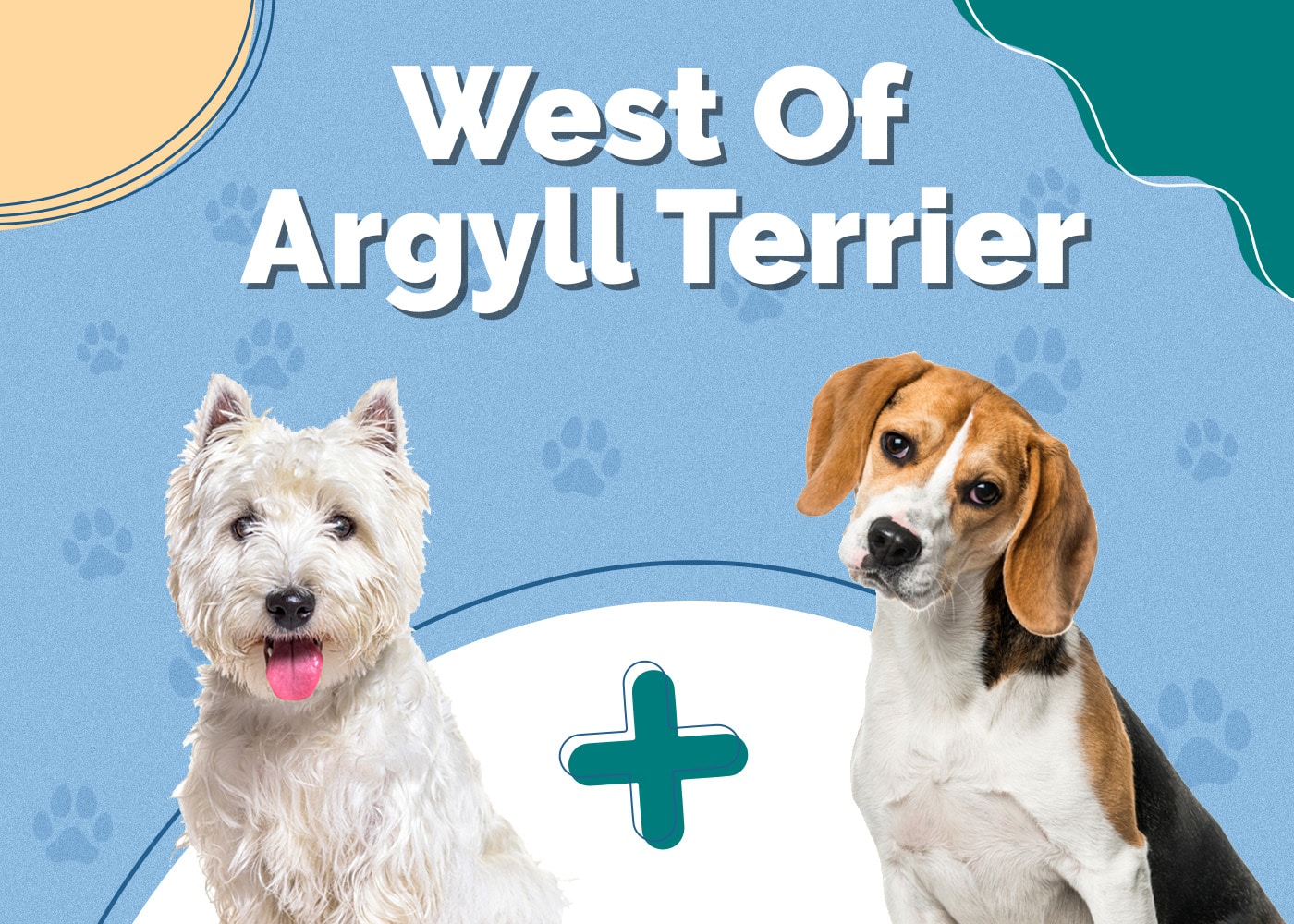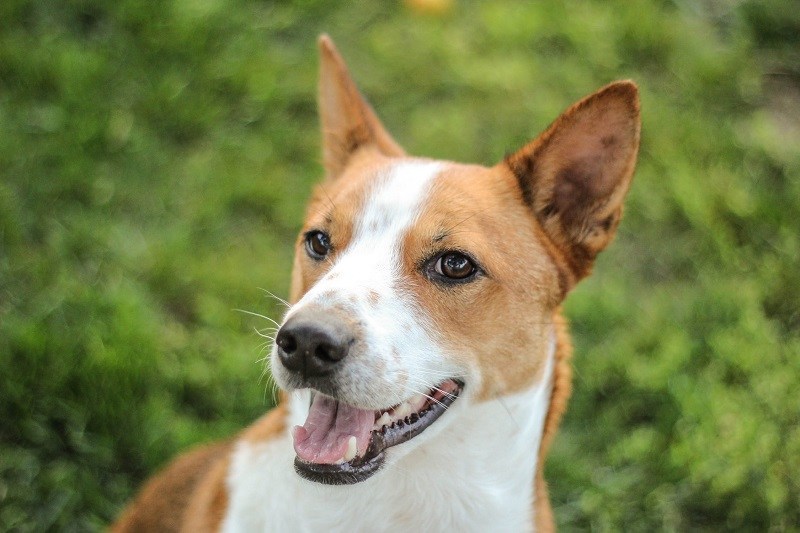West Of Argyll Terrier (Westie & Beagle Mix): Pictures, Care Guide, Temperament & Traits

Updated on

Click to Skip Ahead
The West of Argyll Terrier is relatively new to the Terrier realm, but its temperament and character are all too familiar. As a blend of a West Highland White Terrier and a Beagle, the West of Argyll Terrier is predictably friendly, self-assured, and spirited. Though that makes for a sometimes-stubborn personality, it also allows for an all-around fun, family-friendly pet.
Is this delightful designer dog the right pick for you? We’ll explain what’s in store with this look at the temperament, traits, and care requirements of the West of Argyll Terrier.
Breed Overview
| Height: | 10–15 inches |
| Weight: | 15–25 pounds |
| Lifespan: | 12-15 years |
| Colors: | White, cream, fawn, black, brindle, black & tan, chocolate, red, tricolor |
| Suitable for: | Families, older individuals, apartment residents |
| Temperament: | Energetic, happy, friendly, loving, gentle, independent, cheeky |
The West Highland White Terrier and the Beagle merge to give us the West of Argyll Terrier. The designer breed emerged in the 1990s, marrying the lovability and liveliness of its ancestors to provide tons of entertainment and affection for pet owners. Although not AKC-accepted, the West of Argyll Terrier is a recognized mix from hybrid registries like the American Canine Hybrid Club.
West of Argyll Terriers can be a handful, given that they bark a lot and often let their hard-headedness get the better of them. Bred from English and American hunting dogs, they’re distractible and prone to give chase on a whim. But with a willing, capable owner, they can be excellent company for children, adults, and other pets.
West of Argyll Terrier Characteristics
West of Argyll Terrier Puppies
West of Argyll Terrier puppies bring a wealth of energy, curiosity, and life to the home. While playful and relatively mild-mannered with proper training and socialization, small children may hurt them by being too forceful. With their liveliness and need for mental exercise, preparing toys, activities, and a playtime plan will help you better bond with your puppy and promote faster training.
Since West of Argyll Terriers are a non-Doodle mixed breed, you may have better luck finding them at shelters or for free online. Breeders are few and far between. For help finding one near you, you could contact a local Westie or Beagle breeder for insights.
Being a mix and relatively low in demand, West of Argyll Terriers are inexpensive. They can cost under $200 at a shelter, but if you can find a breeder, they’re often less than $800. With Westies and Beagles running $1,500–$3,000 or more, you can get a delightful blend of their best qualities at a fraction of the cost.

Temperament & Intelligence of the West of Argyll Terrier
West of Argyll Terriers have intelligent parents, with the Westie making Coren’s list of the top 100 most intelligent dogs. The West Highland White Terrier and the Beagle bring a mix of courage, assertiveness, and confidence to the mixed breed. While that makes them a bit difficult at times, it also means West of Argyll Terriers are faithful, funny, and extra-lovable companions for every family member.
Between the Beagle’s curiosity and the Westie’s bold nature, the West of Argyll Terrier can be challenging to train. They’re easy to distract, prone to roaming if they pick up a scent, and given to digging thanks to their earth dog lineage. Expect them to pull at the leash or give you a hard time recalling them off it. If you can supply the attention, patience, and firm guidance they need, they are highly trainable, friendly around people and pets, and patient with children.
Are These Dogs Good for Families? 👪
Westie-Beagle mixes are perfect family dogs that can live in the city as easily as in the country, provided they have a place to walk and play. With their smaller frames, they’re less of a hazard to children. At the same time, they have surprisingly strong, athletic bodies and an even temperament, allowing them to tolerate awkward handling or slightly rough play.
If you need a quiet pet, the West of Argyll Terrier may not be the best choice. Beagles are notorious for their bark, yowl, and whine, and the Westie’s alertness and vigilance are the perfect combination for a loud watchdog.
Does This Breed Get Along With Other Pets?
The West of Argyll Terrier can be a seamless addition to an already pet-filled home. They get along well with cats and dogs and will appreciate a play companion. Having another dog to keep them entertained can also help dispel depression and some of the hazardous side effects of boredom.
Beagles and West Highland White Terriers have a hunting nature, with their primary prey being hares and vermin. As such, a Westie-Beagle mix could be more inclined to pursue and pester smaller pets. But while they may give chase to unfamiliar animals, raising pets of any kind alongside a young West of Argyll Terrier should set the foundation for a happy, fulfilling relationship.
Things to Know When Owning a West of Argyll Terrier:
Food & Diet Requirements 🦴
West of Argyll Terriers are small dogs, often weighing under 25 pounds. They only need about 1–1.5 cups of food separated into two meals daily. Keep fresh water available at all times, and provide a high-quality diet rich in proteins, beneficial fats, and essential nutrients. Avoid giving too many treats, as dogs only need about 10% of their calories from side snacks. As an energetic dog, the West of Argyll Terrier can become overweight and diabetic if overfed and under-exercised.
Exercise 🐕
Beagles and West Highland White Terriers are high-energy pups, a trait they pass on to the West of Argyll Terrier. Westies typically need about 45–60 minutes of daily activity, while Beagles can exercise for 1–2 hours and still have energy for play. In their mixed offspring, you’ll find a dog ready for 30–60 minutes of daily walks and playtime.
Activities like fetch, obstacle courses, or earth dog activities to satisfy their inherited digging desire can delight and tire out your dog. While not a dog needing a job, West of Argyll Terriers can benefit in many ways from enrichment, whether it’s an outdoor activity or an indoor puzzle toy. Boredom and anxiousness can lead to unwanted chewing, digging, or barking. Plan to keep your dog happy and exhausted when you can’t engage them.
Training 🎾
West of Argyll Terriers borrow self-confidence from Westies and an urge to track from Beagles, making for quite the handful when you need to train them. They’re easily distractible and rather stubborn when given enough slack to test their owners.
You must give West of Argyll Terriers attention early and often. Socialization will help lessen aloofness around people. Consistent training is crucial. West of Argyll Terriers need a firm yet gentle hand and positive reinforcement that will keep them in line but maintain a reward-based system to encourage good behavior. They’re food-motivated, giving you a critical aid in maintaining their focus during obedience training.
Grooming ✂️
West of Argyll Terriers borrows more from the West Highland White Terrier. They often have medium-length double coats with lengthy, coarse guard hairs. Their hair sometimes meets at a halfway point between the Beagle’s short, straight coat and the Westie’s wiry, medium-length coat, though typically erring on the latter’s side.
Using a slicker brush 2–3 times weekly will control the dog’s moderate shedding and any matting. Check and clean the ears weekly, as those that inherit their Beagle parent’s floppy ears may be more susceptible to ear infections. Aim to clip their nails 1–2 times monthly and brush their teeth at least once every 1–2 days.
Health and Conditions 🏥
Annual vaccinations, heartworm preventatives, flea and tick medicines, and general checkups are as crucial for West of Argyll Terriers as for any breed. Genetic testing to look into health issues can be challenging, particularly if you adopt from a shelter. As a mix, they may be susceptible to certain disorders common to Westies or Beagles.
- Skin allergies: Skin allergies are a common issue with Westies, which may demand specialty shampoos, antibiotics, or allergy medicines.
- Dental disease: Dental disease is one of the most common issues in Westies. Preventing damaging plaque buildup and periodontal disease requires frequent cleaning and regular checks with the vet.
- Ear infections: Allergies and infections in the floppy West of Argyll Terrier ears can be a recurring issue. Frequent cleaning with an ear-cleaning solution and trimming around the ears are vital.
- Patellar luxation: A slipping kneecap can be mild and manageable for West of Argyll Terriers, though arthritis becomes more likely as they age. More severe conditions in which the kneecap moves and stays out of the groove can cause severe swelling and pain and lead to worsening leg problems.
- Epilepsy: Beagles are more prone to epileptic seizures than many other breeds, sometimes requiring anti-seizure medication.
- Slipped discs: Beagles often develop herniated discs, causing pain and limiting movement. Depending on the severity, a West of Argyll Terrier with intervertebral disc disease will need therapy or possible surgery.
- Legg-Calvé-Perthes disease: Westies are prone to this condition, causing a weak ball joint where the femur meets the hip. The condition, occurring early in life, can lead to arthritis and potentially require surgery.
Male vs. Female
Male and female West of Argyll Terriers share the same general temperament and looks, but you may distinguish unique tendencies between the two if you pay close attention. Males borrow a more aggressive, barking nature from their parents, while females are more playful yet moodier. Many of their issues can even out with spaying and neutering.
Male West of Argyll Terriers are a few pounds larger and a few inches taller than females. Getting a male is an excellent idea if you want a more laid-back West of Argyll Terrier, while females tend to be more playful and open to bonding with every family member.
3 Little-Known Facts About The West of Argyll Terrier
1. West of Argyll Terrier Is a Good Working Dog
Though they are often difficult to train, a well-taught West of Argyll Terrier can also be a versatile helper in several capacities. They make quality service, therapy, and emotional support animals due to their affectionate, patient, and gentle nature. Thanks to their Beagle parent’s superior scent-catching ability, they may even have a place as a detection dog.
2. West of Argyll Terriers Can Sometimes Be Smelly
Westies don’t have a notably potent odor, but we can’t always say the same for the Beagle. As hunting dogs, having a distinct smell was crucial for these hounds to identify one another in the field. Many Beagle owners find they can develop a musty smell, a trait they sometimes pass to the West of Argyll Terrier. Fortunately, many of these mixed dogs draw more coat characteristics from the Westie.
3. West of Argyll Terriers May Inherit One of Many Genetic Disorders
As a mix, the West of Argyll Terrier may benefit from the supposed hybrid vigor stemming from unrelated purebred parents. On the other hand, it can also predispose them to illnesses and issues common to Westies or Beagles. Westies battle disorders like pulmonary fibrosis and various orthopedic problems, while Beagles often suffer from hypothyroidism, epilepsy, and cherry eye.
Final Thoughts
The West of Argyll Terrier is an excitable, upbeat, and ever-alert pup that’s as energetic as it is loud. Early training, socialization, and patience are essential in their upbringing, and you’ll do well to avoid underestimating their care needs. They’re inexpensive to maintain, healthy, and highly adaptable, but no matter what, you must prepare for the loads of affection and fun they want to provide.
Related Read:
- West Highland Doxie (Westie & Dachshund Mix): Pictures, Care Guide, Temperament & Traits
- Westie & Corgi Mix Dog Breed: Pictures, Care Guide Temperament & Traits
Featured Image Credit:













